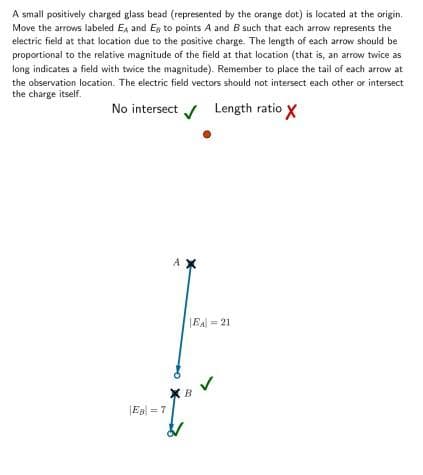A small positively charged glass bead (represented by the orange dot) is located at the origin. Move the arrows labeled EA and Eg to points A and B such that each arrow represents the electric field at that location due to the positive charge. The length of each arrow should be proportional to the relative magnitude of the field at that location (that is, an arrow twice as long indicates a field with twice the magnitude). Remember to place the tail of each arrow at the observation location. The electric field vectors should not intersect each other or intersect the charge itself. No intersect ✓ Length ratio X Ea-7 |EA|-21 B
A small positively charged glass bead (represented by the orange dot) is located at the origin. Move the arrows labeled EA and Eg to points A and B such that each arrow represents the electric field at that location due to the positive charge. The length of each arrow should be proportional to the relative magnitude of the field at that location (that is, an arrow twice as long indicates a field with twice the magnitude). Remember to place the tail of each arrow at the observation location. The electric field vectors should not intersect each other or intersect the charge itself. No intersect ✓ Length ratio X Ea-7 |EA|-21 B
Physics for Scientists and Engineers: Foundations and Connections
1st Edition
ISBN:9781133939146
Author:Katz, Debora M.
Publisher:Katz, Debora M.
Chapter23: Electric Forces
Section: Chapter Questions
Problem 28PQ: A 1.75-nC charged particle located at the origin is separated by a distance of 0.0825 m from a...
Related questions
Question

Transcribed Image Text:A small positively charged glass bead (represented by the orange dot) is located at the origin.
Move the arrows labeled E, and Es to points A and B such that each arrow represents the
electric field at that location due to the positive charge. The length of each arrow should be
proportional to the relative magnitude of the field at that location (that is, an arrow twice as
long indicates a field with twice the magnitude). Remember to place the tail of each arrow at
the observation location. The electric field vectors should not intersect each other or intersect
the charge itself.
No intersect✔✓ Length ratio X
|EB| = 7
||EA| = 21
B
Expert Solution
This question has been solved!
Explore an expertly crafted, step-by-step solution for a thorough understanding of key concepts.
Step by step
Solved in 2 steps with 2 images

Knowledge Booster
Learn more about
Need a deep-dive on the concept behind this application? Look no further. Learn more about this topic, physics and related others by exploring similar questions and additional content below.Recommended textbooks for you

Physics for Scientists and Engineers: Foundations…
Physics
ISBN:
9781133939146
Author:
Katz, Debora M.
Publisher:
Cengage Learning

Principles of Physics: A Calculus-Based Text
Physics
ISBN:
9781133104261
Author:
Raymond A. Serway, John W. Jewett
Publisher:
Cengage Learning

Physics for Scientists and Engineers, Technology …
Physics
ISBN:
9781305116399
Author:
Raymond A. Serway, John W. Jewett
Publisher:
Cengage Learning

Physics for Scientists and Engineers: Foundations…
Physics
ISBN:
9781133939146
Author:
Katz, Debora M.
Publisher:
Cengage Learning

Principles of Physics: A Calculus-Based Text
Physics
ISBN:
9781133104261
Author:
Raymond A. Serway, John W. Jewett
Publisher:
Cengage Learning

Physics for Scientists and Engineers, Technology …
Physics
ISBN:
9781305116399
Author:
Raymond A. Serway, John W. Jewett
Publisher:
Cengage Learning
